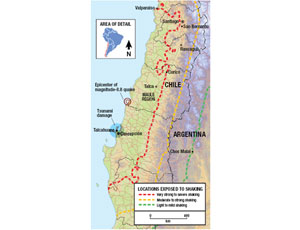Engineers inspecting Chile’s structures after the magnitude-8.8 earthquake that struck the nation’s midsection on Feb. 27 say Chile’s modern buildings are more robust than many equivalent buildings on the West Coast of the U.S. Even concrete frames under construction fared well in the second-strongest temblor on record, say seismic experts.
“It’s amazing how little structural damage there is on new buildings,” says Scott Nyseth, a principal in the Vancouver, Wash., office of Miyamoto International Inc. The amount of shear wall per sq ft of floor area is higher than “anywhere in the world,” he adds. In Chile from March 3-11, Nyseth put “safe to enter” tags on five buildings and a port facility in Concepción, near the epicenter, five in Santiago and four in nearby San Antonio.
To date, the official death toll from the quake, which struck off the coast of the Maule Region south of Santiago, is 497. Insured losses range from $3 billion to $8 billion of the $15 billion to $30 billion in economic damage, according to catastrophe-modeling firm EQECAT.
The Chilean Seismic Code provisions were calibrated for a subduction-type magnitude-8.5 quake that occurs every 70 years along the coastline. Buildings designed and built to the code should resist this type of event with nonstructural damage, acceptable reparable structural damage and no collapse, experts say.
Records indicate that for high-rise buildings, the Feb. 27 quake imposed higher demands than provided by the code. “Nevertheless, in general, buildings behaved quite well,” says structural engineer René Lagos, CEO of the Santiago firm that bears his name.
Lagos says his clients have observed only nonstructural damage to several 15- to 20-story buildings, founded on different soil types, in Concepción.
In Concepción, two buildings had major structural damage. One had significant shear failures, and the other, the 14-story residential Torre Alto Rio, toppled like a tree. The base of the building, developed by Inmobiliaria Rio Huequen and constructed by Socovil, appeared to lack adequate vertical reinforcement and horizontal confinement, says Nyseth. “There were almost zero ties,” he says.
There was no structural damage to the 25-story concrete frame of the future 300-m-tall Costanera Tower, a Lagos job that resumed construction in early February after a year’s hiatus because of the weak economy. The only damage was caused by concrete blocks from the crane that fell 120 m and crushed slabs in the shopping-mall section of the complex.
The damaged Santiago airport has reopened but without the use of the international terminal, which suffered mainly nonstructural damage. Suspended ceilings collapsed; air-conditioning units fell through slabs and more, says Gilberto Mosqueda, a professor of engineering at the University at Buffalo and part of a reconnaissance team in Chile.
Santiago city services are restored, except for a damaged section of the Metro. But the Felix Bulnes Hospital will be shuttered for several months. The second level of a 1980s addition had no identifiable lateral resisting system, says Mosqueda.
Concepción still lacks services. The national government says overall reconstruction could take four years.





Post a comment to this article
Report Abusive Comment